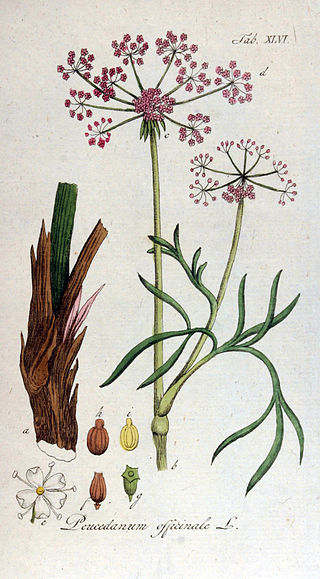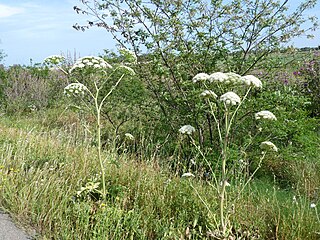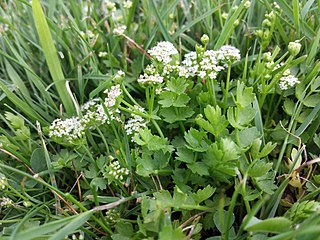
Scabiosa is a genus in the honeysuckle family (Caprifoliaceae) of flowering plants. Many of the species in this genus have common names that include the word scabious, but some plants commonly known as scabious are currently classified in related genera such as Knautia and Succisa; at least some of these were formerly placed in Scabiosa. Another common name for members of this genus is pincushion flowers.

Chard or Swiss chard is a green leafy vegetable. In the cultivars of the Flavescens Group, the leaf stalks are large and often prepared separately from the leaf blade; the Cicla Group is the leafy spinach beet. The leaf blade can be green or reddish; the leaf stalks are usually white, yellow or red.

Salix × fragilis, with the common names crack willow and brittle willow, is a hybrid species of willow native to Europe and Western Asia. It is native to riparian habitats, usually found growing beside rivers and streams, and in marshes and water meadow channels. It is a hybrid between Salix euxina and Salix alba, and is very variable, with forms linking both parents.

Armeria maritima, the thrift, sea thrift or sea pink, is a species of flowering plant in the family Plumbaginaceae. It is a compact evergreen perennial which grows in low clumps and sends up long stems that support globes of bright pink flowers. In some cases purple, white or red flowers also occur. It is a popular garden flower and has been distributed worldwide as a garden and cut flower. It does well in gardens designed as xeriscapes or rock gardens. The Latin specific epithet maritima means pertaining to the sea or coastal.

Peucedanum is a genus of flowering plant in the carrot family, Apiaceae. Peucedanum boasts a global presence with diverse spread of morphological features. Peucedanum species are characterized by dorsally compressed mericarps, slightly prominent dorsal ribs, narrowly winged lateral ribs, and a broad commissure. However, the vast diversity of morphology, fruit forms, and phytochemical production makes classifying species in the Peucedanum challenging. Historically relevant in traditional medicine, Peucedanum's taxonomic complexity arises from its extensive diversity.

Magydaris is a genus of perennial herbs in the family Apiaceae, native to the western and central Mediterranean.

Wilhelm Daniel Joseph Koch was a German physician and botanist from Kusel, a town in the Rhineland-Palatinate.

Omalotheca is a genus of flowering plants in the daisy family. It is commonly known as arctic cudweed.

Seseli is a genus of herbaceous perennial plants in the family Apiaceae. They are sometimes woody at base with a conic taproot. Leaf blades are 1–3-pinnate or pinnately decompound. Umbels are compound, with bracts few or absent. Petals are white or yellow, and the fruit ovoid or ellipsoid.

Helosciadium nodiflorum, fool's watercress, is a flowering plant found in ditches or streams, as well as fresh and brackish-water wetlands native to western Europe. It is not poisonous to humans but it could be easily confused with the allegedly poisonous lesser water parsnip.

Ferulago is a genus of flowering plants in the family Apiaceae.

Seseli libanotis, also known by the common names moon carrot, mountain stone-parsley, or säfferot, is a species of herb in the genus Seseli of the carrot family, Apiaceae. It is native to Eurasia, throughout which it is widespread.

Helosciadium × longipedunculatum, synonym Apium × longipedunculatum, is a hybrid plant in the umbellifer family (Apiaceae); the result of hybridisation between Helosciadium repens and Helosciadium nodiflorum.

Callitriche hamulata is a species of flowering plant belonging to the family Plantaginaceae.

Trochiscanthes is a genus of flowering plants belonging to the family Apiaceae. It has only one species, Trochiscanthes nodiflora. Its native range is Central Europe.

Conopodium is a genus of flowering plants belonging to the family Apiaceae.
Ptychotis is a genus of flowering plants belonging to the family Apiaceae.

Helosciadium repens commonly known as creeping marshwort, is a species of plant belonging to the Apiaceae family. It occurs in Western and Central Europe, being rare throughout its range. It grows in wetland areas where it does not have to compete with taller plants due to grazing by animals, periodic flooding during the winter-spring seasons, or mowing. It is considered a species of near-threatened status at the continental level, critically endangered and legally protected in Poland. It is subject to protection within the European Natura 2000 network.

















